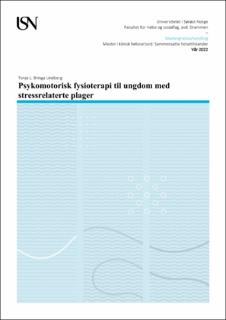| dc.contributor.advisor | Brembo, Espen Andreas | |
| dc.contributor.advisor | Gonzalez, Marianne Thorsen | |
| dc.contributor.author | Lindberg, Tonje Loise Bringa | |
| dc.date.accessioned | 2022-08-11T16:42:13Z | |
| dc.date.available | 2022-08-11T16:42:13Z | |
| dc.date.issued | 2022 | |
| dc.identifier | no.usn:wiseflow:6537486:49181247 | |
| dc.identifier.uri | https://hdl.handle.net/11250/3011387 | |
| dc.description.abstract | Bakgrunn: I praksis erfares det et stort sprik mellom den enkelte ungdom, modenhet og oppvekstvillkår. De står alle imellom barn og voksenlivet, eller «nesten barn», hvor det skjer mange kroppslige prosesser. Ungdommen kan oppleve stress, bekymringer, konflikter, traumatiske opplevelser og livsbelastninger som vil påvirke deres kropp og kroppsopplevelse. Statsminister Jonas Gahr Støre har startet en opptrappingsplan for psykisk helse med store bekymringer for økende psykiske utfordringer hos barn og unge. Ungdommen er «vår fremtid» og derfor en viktig gruppe å satse på med helsefremmede tiltak.
Formål: Masteroppgaven har til hensikt å utforske psykomotorisk fysioterapeuters praksiserfaringer i sitt arbeid med ungdom som strever med stressrelaterte plager. Målet med oppgaven er å fremskaffe mer dybdekunnskap om hva som karakteriserer psykomotoriske fysioterapeuters kliniske praksis. Problemstillingen lyder: «Hvordan beskriver psykomotoriske fysioterapeuter sin terapeutiske praksis til ungdom med stressrelaterte plager?»
Metode: I denne studien er det utført semistrukturerte kvalitative intervjuer av psykomotoriske fysioterapeuter i et hermeneutisk perspektiv. Det ble gjort et strategisk utvalg av fem erfarne psykomotoriske fysioterapeuter som arbeider med ungdom med stressrelaterte plager i sin praksis. Intervjuene ble utført individuelt med fysisk tilstedeværelse eller digitalt med videosamtale på grunn av nåtidens pandemi. Intervjuene er analysert ut fra Graneheim og Lundman (2004) sin metode for kvalitativ innholdsanalyse.
Resultat: Gjennom analysen av intervjuene fremsto tre overordnede temaer som sentrale tilnærminger, 1: Å jobbe personorientert i klinisk praksis som psykomotorisk fysioterapeut. Innholdet og strukturen i anamnesen var ikke fullt så viktig som hvordan den foregikk og i prosessen vektla informantene å tune seg inn på ungdommens livsverden og møte de der de er i øyeblikket. 2: Å fremme økt kontakt og opplevelse av egen kropp. Ungdommen blir lært opp til å bli bevisst og gjenkjenne kroppens ulike måter å uttrykke seg på, samt å oppøve evne til å sette ord på dette for å øke kroppskontakt. 3: Å hjelpe ungdommen å forstå kroppslige uttrykk. Psykomotoriske fysioterapeutene anvendte ulike bevegelsesøvelser, forklaringer og språklige virkemidler for å hjelpe ungdommen til å oppnå økt erkjennelse av det som foregår i kroppen.
Konklusjon: Psykomotoriske fysioterapeuters terapeutiske tilnærming rettet mot ungdom med stressrelaterte plager er personorientert hvor de vektlegger relasjonsbygging for å skape en utforskende arbeidsallianse. De anvender ulike metoder i sitt arbeid hvor målet er kroppslig erkjennelse som forutsetning for bedringsprosesser. Det kommer frem at ungdom lærer og catcher ting raskt sammenlignet med eldre ved deres kroppslige fleksibilitet, og at de ikke er fullt så fastlåst i sin atferd og forståelsesramme knyttet til kroppslige uttrykk. Dette fremmer psykomotorisk fysioterapi å være relevant tilnærming for å imøtekomme ungdommens utfordringer med stressrelaterte plager. | |
| dc.description.abstract | Background: In practice, there is a substantial gap between the individual adolecents’ maturity and growing up conditions. They are all between children and adulthood, or "almost children", where many bodily processes take place. Adolescents can experience stress, worries, conflicts, traumatic experiences and life stresses that affect their perception of their body and bodily experiences. Prime Minister Jonas Gahr Støre has started an escalation plan for mental health describing major concerns about increasing mental challenges in children and young people. Young people are "our future" and therefore an important group to focus on with health-promoting measures.
Purpose: This master's thesis aims to explore psychomotor physiotherapists' practice experiences in their work with adolecents who struggle with stress-related ailments. The goal of the thesis is to provide more in depth knowledge about characteristic features of psychomotor physiotherapists’ clinical practice. The research question is: "How do psychomotor physiotherapists describe their therapeutic practice for adolescents with stress-related ailments?"
Method: In this study, qualitative semi-structured interviews with psychomotor physiotherapists were conducted in a hermeneutic perspective. A strategic selection was made of five experienced psychomotor physiotherapists who work with adolescents with stress-related ailments in their daily practice. The interviews were conducted individually with physical presence or digitally due to the current pandemic. The analysis of the data material was inspired by Graneheim and Lundman (2004)'s method for qualitative content analysis.
Result: Through the analysis of the interviews, three main themes emerged as characteristic features, 1: Working personoriented in clinical practice as a psychomotor physiotherapist. The content and the structure of the anamnesis was not quite as important as how it was carried out. They emphasized tuning in to the adolecents’ lifeworld, and meeting them where they are at the moment. 2: To promote increased contact and experience of one's own body. The adolecents were taught how to become aware of and recognize the different bodily expressions, as well as articulating these sensations in own words as means to increase bodily self-awareness. 3: To help young people understand bodily expressions. The informants used various movement exercises, explanations and linguistic tools in the process of helping the adolecent to gain increased understanding of what is happening in the body.
Conclusion: Psychomotor physioterapists’ terapeutic approach towards adolecents with stress-related ailments is personoriented where they stress relationship-building to create an exploratory work alliance. They utilize different methods where the goal is bodily self-awareness as a prerequisite for recovery. It turns out that young people learn and catch things quickly compared to older people by their bodily flexibility, and in that they are not quite as locked into behavioural and cognitive patterns related to bodily expressions. This promotes psychomotor physiotherapy to be a relevant approach to addressing adolescents' challenges with stress-related ailments. | |
| dc.language | nob | |
| dc.publisher | University of South-Eastern Norway | |
| dc.title | Psykomotorisk fysioterapi til ungdom med stressrelaterte plager | |
| dc.type | Master thesis | |
